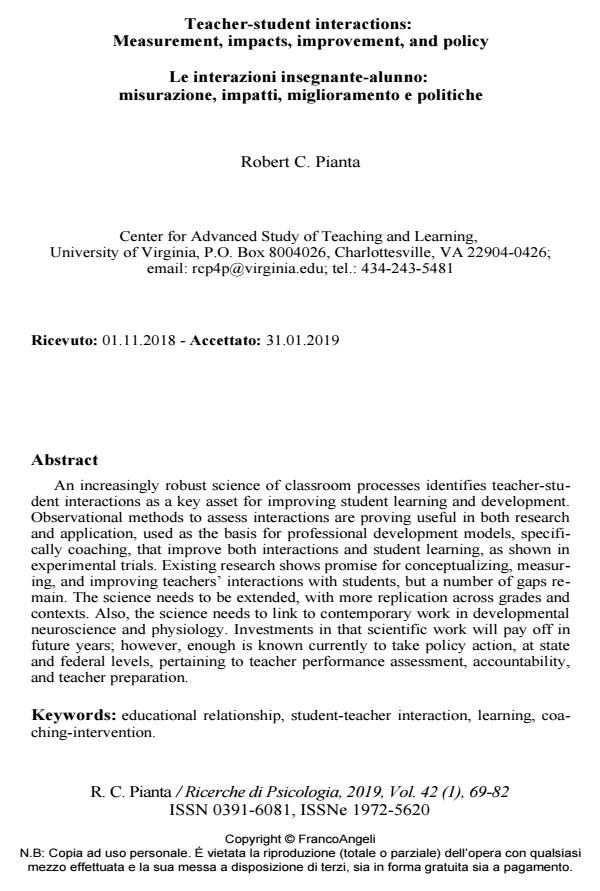Teacher-student interactions: Measurement, impacts, improvement, and policy
Journal title RICERCHE DI PSICOLOGIA
Author/s Robert C. Pianta
Publishing Year 2019 Issue 2019/1
Language English Pages 14 P. 69-82 File size 197 KB
DOI 10.3280/RIP2019-001005
DOI is like a bar code for intellectual property: to have more infomation
click here
Below, you can see the article first page
If you want to buy this article in PDF format, you can do it, following the instructions to buy download credits

FrancoAngeli is member of Publishers International Linking Association, Inc (PILA), a not-for-profit association which run the CrossRef service enabling links to and from online scholarly content.
An increasingly robust science of classroom processes identifies teacher-student interactions as a key asset for improving student learning and develop-ment. Observational methods to assess interactions are proving useful in both research and application, used as the basis for professional development models, specifically coaching, that improve both interactions and student learning, as shown in experimental trials. Existing research shows promise for conceptualiz-ing, measuring, and improving teachers’ interactions with students, but a number of gaps remain. The science needs to be extended, with more replication across grades and contexts. Also, the science needs to link to contemporary work in de-velopmental neuroscience and physiology. Investments in that scientific work will pay off in future years; however, enough is known currently to take policy action, at state and federal levels, pertaining to teacher performance assessment, accountability, and teacher preparation.
Keywords: Educational relationship, student-teacher interaction, learning, coa-ching-intervention.
- The representation of child–parent relation: validation of the Italian version of the child–parent relationship scale (CPRS-I) Teresa Rinaldi, Ilaria Castelli, Nicola Palena, Andrea Greco, Robert Pianta, Antonella Marchetti, Annalisa Valle, in Frontiers in Psychology 1194644/2023
DOI: 10.3389/fpsyg.2023.1194644 - Studying students’ opinions as a stage of designing proactive preparation for provid-ing moral education Elena Mikhailovna Kharlanova, Svetlana Vasilyevna Roslyakova, Nadezhda Valeryevna Sivrikova, Tatyana Gennadyevna Ptashko, Nadezhda Anatolyevna Sokolova, in Science for Education Today /2021 pp.46
DOI: 10.15293/2658-6762.2104.03 - Mentalizing School. Could develop the ability to mentalize support the functioning of students, parents, and teachers in the school environment? An attempt to answer the question taking into account reports from international research. Marta Bodecka-Zych, in Studia z Teorii Wychowania /2023 pp.259
DOI: 10.5604/01.3001.0053.9207 - Mentalization and attachment in educational relationships at primary school Annalisa Valle, Teresa Rinaldi, Andrea Greco, Robert Pianta, Ilaria Castelli, Antonella Marchetti, in RICERCHE DI PSICOLOGIA 1/2022 pp.1
DOI: 10.3280/rip2022oa13226 - Exploring classroom interaction in online education Saliha Toscu, in Education and Information Technologies /2023 pp.11517
DOI: 10.1007/s10639-023-11622-x
Robert C. Pianta, Teacher-student interactions: Measurement, impacts, improvement, and policy in "RICERCHE DI PSICOLOGIA " 1/2019, pp 69-82, DOI: 10.3280/RIP2019-001005